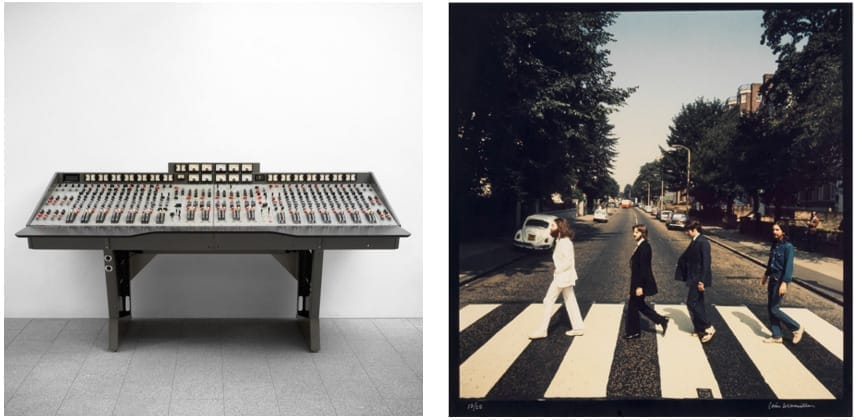London – Abbey Road, the last album recorded by The Beatles, is one of the most groundbreaking albums of all time. Named after the now world-famous road on which the recording studios are situated in London, the album’s distinctive sound is indebted to the studios’ EMI TG12345 Mk I console that it was produced on. Developed specifically by EMI, the console was installed at the studio in 1968, and was used by The Beatles to record and mix their legendary album, Abbey Road in 1969, resulting in a smoother more polished sound. The first solid-state transistorised desk built by EMI, known as The Beatles Abbey Road console, is to be offered for the first time at auction in Bonhams’ dedicated sale, Sound of The Beatles: The ‘Abbey Road’ Console, on Thursday 14 December at Bonhams Knightsbridge, London.
Claire Tole-Moir, Head of Bonhams Popular Culture department, commented: “Abbey Road was unlike any of the Beatles’ previous albums. This TG console allowed the Beatles to realise their creative ambitions for what would be their final album recorded together. Since its release, ‘Abbey Road’ has sold over 19 million copies, and is considered one of the most important albums of the Twentieth Century. The album’s name and instantly recognisable cover has made it synonymous with the studios at which it was recorded. The commercial success and cultural impact were such that EMI Studios even rebranded as Abbey Road Studios, reinforcing their status at the forefront of the recording industry. This console is an incredibly important piece of Beatles history, and of music history overall – and Bonhams is honoured to bring it to auction.”
With eight-track recording in the late ’60s having pushed the technical capabilities of the REDD consoles to their limits, it was decided in 1967 that a new type of desk would be designed. This was a joint project between the Abbey Road recording engineers and the Central Research Laboratories (CRL) at the EMI Hayes factories.
This EMI TG12345 prototype (later known as the Mk I) boasted technological innovations that were previously impossible. Initially installed in the experimental room (Room 65) at Abbey Road in the summer of 1968, it was then installed in Studio 2 for use by recording artists.
The historic importance of this console did not end with the recording of Abbey Road, as it continued to be used by each of the Fab Four on their respective solo projects; John Lennon’s Plastic Ono Band, George Harrison’s classic All Things Must Pass, tracks from Paul McCartney’s self-titled album and Ringo’s Sentimental Journey.
After being removed from service at Abbey Road due to the introduction of the latest TG MK II console in 1971, the desk was dismantled with parts being donated to a school in North London. When no longer needed by the school, they were discarded, and later recovered by a tape machine maintenance engineer. The current owner has painstakingly reunited the surviving original parts and professionally restored the console to its former glory. Having undergone a comprehensive, state-of-the-art restoration process over the last four years, the console is now back to working order and comprises the majority of original parts from the historic Abbey Road recording sessions.
The department advises that the estimate, although unpublished, is a seven-figure sum. The console will be on public preview at Bonhams Knightsbridge from 8-14December.
The sale will also include a curated selection of artefacts relating to The Beatles and Abbey Road, including:
- A Psychedelic Abbey Road Logo Illuminated Sign From Abbey Road Studios, circa 1970. Estimate: £ 8,000 – 12,000. Designed by artist Alan Brown, this sign was installed in Abbey Road, originally used as a small table in the reception area, then later displayed on the wall behind the reception desk in the early 1970s.
- Iain Macmillan (British, 1938-2006): Two prints of The Beatles on Abbey Road, 1969. Estimate: £18,000 – 20,000. Having met John Lennon at the Indica Gallery with Yoko Ono in 1966, Macmillan was invited by Lennon to photograph the Beatles for the cover of their final album ‘Abbey Road’. Having decided to name their album after Abbey Road in St John’s Wood, London, where the EMI Studios were situated, they knew this was to be featured on the album cover. Armed with a sketch Paul McCartney had given Macmillan a couple of days before of what the picture should look like, he knew he didn’t have long to get the right shot for the world’s most famous band. On 8th August 1969, at around 11:30 am, a hired policeman stopped the traffic at the zebra crossing just outside, Macmillan climbed up a large stepladder in the middle of Abbey Road and took just six pictures of the Beatles crossing the street. In just 10 minutes Macmillan shot the band in various directions, but it was frame no.5 that was used for the cover of the album – the only photo where all four of them are walking in perfect formation.
- John Lennon: An EMT 140 Echo Plate Reverb Unit Owned by John Lennon and used for the Recording of Imagine, circa 1970. Estimate: £15,000-20,000. The present piece of studio equipment is one of two important examples acquired by Audiotek, who installed it the music studio at John Lennon’s home at Tittenhurst Park, believed to be the first professional home music studio in the United Kingdom.
